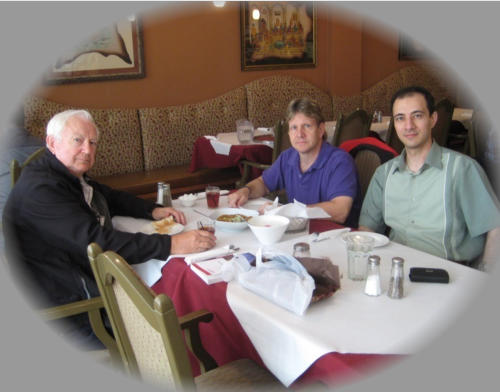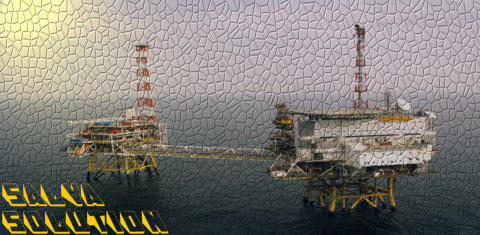I
started
SalvaSolution
Ltd.
in
2017
to
help
senior
students
and
professional
Process
Engineers
dealing
with
the
critical
task
of
equipment
sizing/costing.
Acquired
knowledge
and
experience
from
my
graduate
studies
career
and
industrial
practice,
I
have
developed
and
published
several
mobile
apps
which
are
working
flawlessly
on
various
platforms.
Here
is
a
short
story
on
how
the
multiphase separator sizing apps came to the reality:
The
classic
method
of
Svrcek-Monnery
was
over
there
for
decades
and
had
earned
fantastic
popularity
and
international
reputation.
However,
after
several
empirical
experiments,
Dr.
Svrcek
and
Dr.
Monnery
had
noticed
that
some
tangible
improvements
would
be
offered
if
their
observations
could
be
generalized
through
industrial
scale
empirical
data
and
CFD
simulations.
At
this
stage,
I
got
a
chance
to
work
with
these
gentlemen
to
improve
the
original
design
criteria
based
on
the
empirical
findings
and
realistic
CFD
simulations.
Within
a
course
of
five
years,
the
project
was
completed
successfully
and
I
gained
my
PhD
in
2010
under
their
supervision.
Later
years,
we
published
one
book
and
five
technical
papers
addressing
the
performed
research
work
and its significant results
.
A Lovely Gathering after Publication of our Book.
From Left: Dr. Svrcek, Dr. Monnery, and Me.
You
can
download
my
thesis
in
the
Kindle
format
from
here
.
Considering
the
fact
that
our
new
technology-oriented
world
urges
more
availability
and
convenience,
I
decided
to
share
the
ultimate
design
criteria
we
elucidated
from
our
extensive
investigations
with
you,
motivated
Process Engineers all around the world.
Currently,
my
developed
mobile
apps
have
found
their
ways
to
the
global
App
Stores
of
Apple,
Android
and
etc.
and
received
serious
expert
attention.
While
I
have
provided
some
supportive
information
here,
please
feel
free
to
contact
me
at
inquiry@salvasolution.com
if
you
have
any
unanswered questions. I’ll do my best to respond them within a couple of days.
Finally, you find a list of our contribution to the CFD-based optimum design of the oilfield
separators literature:
Book
Pourahmadi Laleh, A., Svrcek, W.Y., Monnery, W.D., “CFD Simulation of Oilfield Separators: A
Realistic Approach”, LAMBERT Academic Publishing, 2011.
Overview:
In
this
book,
a
realistic
simulation
approach
based
on
Computational
Fluid
Dynamics
(CFD)
is
developed
to
provide
high-quality
visualization
of
the
multiphase
separation
process.
Furthermore,
classic
separator
design
methodologies
are
evaluated
and
improved
design
criteria
are
proposed.
A
useful
method
is
presented
for
estimation
of
the
droplet
sizes
used
to
calculate
realistic
separation
velocities
for
various
oilfield
conditions.
The
velocity
constraints
associated
with
re-entrainment
phenomenon
are
also
discussed
and
novel
correlations
are
provided.
This
book,
also
demonstrates
the
benefits
that
CFD
analyses
provide
in
optimizing
the
design
of
new
separators and solving problems with existing designs.
Papers
1. Svrcek, W.Y., Monnery, W.D., “Design Two-Phase Separators within the Right Limits”, Chem.
Eng. Progress, 89(10), 1993, 53-60.
Overview:
This
internationally-acclaimed
paper
presents
an
algorithmic
method
for
sizing
the
most
economical
two-phase
separator.
Different
approaches,
i.e.
GPSA,
York
Demister,
and
Theoretical,
to
estimating
phase
separation
velocities
are
included.
The
design
procedure
is
explained by worked examples.
2. Monnery, W.D., Svrcek, W.Y., “Successfully Specify Three-Phase Separators”, Chem. Eng.
Progress, 90(9), 1994, 29-40.
Overview:
This
internationally-acclaimed
paper
presents
an
algorithmic
method
for
sizing
the
most
economical
three-phase
separator.
Different
approaches,
i.e.
GPSA,
York
Demister,
and
Theoretical,
to
estimating
phase
separation
velocities
are
included.
The
design
procedure
is
explained by worked examples.
3. Pourahmadi Laleh, A., Svrcek, W.Y., Monnery, W.D., “Computational Fluid Dynamics
Simulation of Pilot-Plant-Scale Two-Phase Separators”, Chemical Engineering and Technology,
34(2), 2011, 296-306.
Overview:
Two
computational
fluid
dynamics
(CFD)
modeling
approaches,
the
discrete
phase
model
(DPM)
and
the
combination
of
volume
of
fluid
(VOF)
and
DPM,
are
developed
to
simulate
the
phase
separation
phenomenon
in
four
pilot-plant
scale
separators.
The
incipient
vapor
phase
velocity,
at
which
liquid
droplet
carryover
occurs,
and
separation
efficiency
plots
are
used
as
criteria
for
evaluating
the
developed
CFD
models.
The
simulation
results
indicate
that
the
VOF-DPM
approach
is
a
substantial
modification
to
the
DPM
approach
in
terms
of
the
predicted
separation
efficiency
data
and
diagrams.
CFD
simulation
profiles
demonstrate
that
all
the
separators
are
essentially
operating
at
a
constant
pressure.
The
CFD
results
also
show
that
mist
eliminators
may
operate
more
efficiently
in
horizontal
separators
than
in
vertical
separators.
4. Pourahmadi Laleh, A., Svrcek, W.Y., Monnery, W.D., “Design and CFD Studies of Multiphase
Separators-A Review", The Canadian Journal of Chemical Engineering, 90(6), 2012, 1547-1560.
Overview:
The
literature
on
the
multiphase
separators
abounds
with
macro
studies
and
design
methodologies
for
two-
and
three-phase
vertical
and
horizontal
separators.
There
are
very
few
studies
that
provide
the
micro
details
of
the
actual
separation
process.
This
paper
reviews
the
important
relevant
literature
for
multiphase
separators
and
does
include
the
few
CFD-based
studies
of
multiphase
separators.
However,
classic
guidelines
for
design
of
multiphase
separators
and
two
academic
experimental
research
projects
have
also
been
reviewed.
In
the
classic
methods,
vapour–liquid
and
liquid–liquid
separation
compartments
are
designed
based
on
droplet
settling
theory.
Moreover,
the
retention
time
of
liquid
phase
is
selected
based
on
empirical
data
or
heuristics
for
establishing
a
safe
and
smooth
operation
of
the
separator
and
downstream
equipment.
In
fact,
the
popular
classic
methods
for
separator
design,
mostly
due
to
a
lack
of
a
usable
mathematical
model
for
estimation
of
phase
separation
velocities,
do
result
in
a
conservative
design
and
would
specify
extremely
oversized
separators.
In
order
to
reflect
the
current
situation
and
address
recent
findings,
this
study
reviews
the
important
literature
on
design
and
CFD
simulation
of
multiphase
separators.
This
review
shows
the
benefits
that
CFD
analyses
can
provide
in
optimising
the
design
of
new
separators
and
solving
problems
with
existing designs.
5. Pourahmadi Laleh, A., Svrcek, W.Y., Monnery, W.D., “Design Criteria for Oilfield Separators
Improved by Computational Fluid Dynamics”, Chemical Engineering and Technology, 35(2),
2012, 323-333.
Overview:
Oilfield
separator
data
ranging
from
light-oil
conditions
to
heavy-oil
conditions
were
incorporated
into
suitable
two-phase
and
three-phase
computational
fluid
dynamics
(CFD)
models
to
provide
improved
design
criteria
for
separator
design
methods.
The
CFD
simulation
results
revealed
that
the
most
important
affecting
parameters
are
vapor
density
and
oil
viscosity.
In
contrast
with
the
classic
design
methods,
noticeable
residence
times
were
required
for
liquid
droplets
to
penetrate
through
the
fluid
interfaces.
Moreover,
it
was
indicated
that
the
Abraham
equation
should
be
used
instead
of
the
Stokes’
law
in
the
liquid-liquid
separation
calculations.
The
velocity
constraints
caused
by
re-entrainment
in
horizontal
separators
were
also
studied
and
led to novel correlations.
6. Pourahmadi Laleh, A., Svrcek, W.Y., Monnery, W.D., “Computational Fluid Dynamics-Based
Study of an Oilfield Separator-Part I: A Realistic Simulation", SPE-Oil and Gas Facilities, 1(6),
2012, 57-68.
Overview:
A
realistic
CFD
simulation
of
a
field
three-phase
separator
has
been
developed.
This
realistic
simulation
provides
an
understanding
of
both
microscopic
and
macroscopic
features
of
the
three-phase
separation
phenomenon.
For
simulation
purposes,
an
efficient
combination
of
two
multiphase
models
of
the
commercial
CFD
software,
ANSYS
Fluent,
was
implemented.
The
flow-distributing
baffles
and
wire
mesh
demister
were
also
modeled
using
the
porous
media
model.
Furthermore,
a
useful
approach
to
estimating
the
particle
size
distribution
in
oilfield
separators
was
developed.
The
simulated
fluid-flow
profiles
are
realistic
and
the
predicted
separation efficiencies are consistent with oilfield experience.
7. Pourahmadi Laleh, A., Svrcek, W.Y., Monnery, W.D., “Computational Fluid Dynamics-Based
Study of an Oilfield Separator-Part II: An Optimum Design", SPE-Oil and Gas Facilities, 2(1),
2013, 52-59.
Overview:
This
paper
provides
details
of
comprehensive
CFD-based
studies
performed
to
overcome
the
separation
inefficiencies
experienced
in
a
large-scale
three-phase
separator.
It
is
shown
that
the
classic
design
methods
are
too
conservative
and
would
result
in
oversized
separators.
In
this
study,
effective
CFD
models
were
developed
to
estimate
the
phase-separation
parameters
that
were
integrated
into
an
algorithmic
design
method
to
specify
a
realistic
optimum
separator.
The
CFD
simulations
indicated
that
noticeable
residence
times
are
required
for
liquid
droplets
to
penetrate
through
the
interfaces,
and
liquid
droplets
would
be
re-entrained
from the liquid-liquid interface vicinity by the continuous liquid phase.








Ali P. Laleh, PhD, P.Eng.
To
talk
a
bit
about
myself
and
my
professional
passion
here,
I
have
more
than
20
years
of
experience
as
a
Process
Optimization
and
Research
Engineer,
involved
in
rectifying
inefficiencies
of
industrial
scale
processes
and
optimizing
chemical
plants.
My
background
has
been
formed
with
a
strong
orientation
toward
oil
production
and
petrochemical
processes,
and
I
have
a
BSc
(2000),
a
MSc
(2003)
and
a
PhD
(2010)
all
in
the
field
of
Chemical
Engineering.


My
background
has
been
formed
with
a
strong
orientation
toward
oil
production
and
petrochemical
processes,
and
I
have
a
BSc
(2000),
a
MSc
(2003)
and
a
PhD
(2010)
all
in
the
field
of
Chemical
Engineering.
I
started
SalvaSolution
Ltd.
in
2017
to
help
senior
students
and
professional
Process
Engineers
dealing
with
the
critical
task
of
equipment
sizing/costing.
Acquired
knowledge
and
experience
from
my
graduate
studies
career
and
industrial
practice,
I
have
developed
and
published
several
mobile
apps
which
are
working
flawlessly
on
various
platforms.
Here
is
a
short
story
on
how
the
multiphase
separator
sizing
apps
came
to
the reality:
The
classic
method
of
Svrcek-Monnery
was
over
there
for
decades
and
had
earned
fantastic
popularity
and
international
reputation.
However,
after
several
empirical
experiments,
Dr.
Svrcek
and
Dr.
Monnery
had
noticed
that
some
tangible
improvements
would
be
offered
if
their
observations
could
be
generalized
through
industrial
scale
empirical
data
and
CFD
simulations.
At
this
stage,
I
got
a
chance
to
work
with
these
gentlemen
to
improve
the
original
design
criteria
based
on
the
empirical
findings
and
realistic
CFD
simulations.
Within
a
course
of
five
years,
the
project
was
completed
successfully
and
I
gained
my
PhD
in
2010
under
their
supervision.
Later
years,
we
published
one
book
and
five
technical
papers
addressing
the
performed
research work and its significant resul
t
s.
A Lovely Gathering after Publication of our Book.
From Left: Dr. Svrcek, Dr. Monnery, and Me.
You
can
download
my
thesis
in
the
Kindle
format
from
here
.
Considering
the
fact
that
our
new
technology-oriented
world
urges
more
availability
and
convenience,
I
decided
to
share
the
ultimate/applied
design
criteria
we
elucidated
from
our
extensive
investigations
with
you,
motivated
Process Engineers all around the world.
Currently,
my
developed
mobile
apps
have
found
their
ways
to
the
global
App
Stores
of
Apple,
Android
and
etc.
and
received
serious
expert
attention.
While
I
have
provided
some
supportive
information
here,
please
feel
free
to
contact
me
at
inquiry@salvasolution.com
if
you
have
any
unanswered
questions.
I’ll
do
my
best
to
respond
them
within a couple of days.
Finally, here is a list of our contribution to the CFD-based
optimum design of the oilfield separators literature:
Book
Pourahmadi Laleh, A., Svrcek, W.Y., Monnery, W.D., “CFD
Simulation of Oilfield Separators: A Realistic Approach”,
LAMBERT Academic Publishing, 2011.
Overview:
In
this
book,
a
realistic
simulation
approach
based
on
Computational
Fluid
Dynamics
(CFD)
is
developed
to
provide
high-quality
visualization
of
the
multiphase
separation
process.
Furthermore,
classic
separator
design
methodologies
are
evaluated
and
improved
design
criteria
are
proposed.
A
useful
method
is
presented
for
estimation
of
the
droplet
sizes
used
to
calculate
realistic
separation
velocities
for
various
oilfield
conditions.
The
velocity
constraints
associated
with
re-entrainment
phenomenon
are
also
discussed
and
novel
correlations
are
provided.
This
book,
also
demonstrates
the
benefits
that
CFD
analyses
provide
in
optimizing
the
design
of
new
separators and solving problems with existing designs.
Papers
1. Svrcek, W.Y., Monnery, W.D., “Design Two-Phase
Separators within the Right Limits”, Chem. Eng. Progress,
89(10), 1993, 53-60.
Overview:
This
internationally-acclaimed
paper
presents
an
algorithmic
method
for
sizing
the
most
economical
two-
phase
separator.
Different
approaches,
i.e.
GPSA,
York
Demister,
and
Theoretical,
to
estimating
phase
separation
velocities
are
included.
The
design
procedure
is
explained
by worked examples.
2. Monnery, W.D., Svrcek, W.Y., “Successfully Specify
Three-Phase Separators”, Chem. Eng. Progress, 90(9), 1994,
29-40.
Overview:
This
internationally-acclaimed
paper
presents
an
algorithmic
method
for
sizing
the
most
economical
three-
phase
separator.
Different
approaches,
i.e.
GPSA,
York
Demister,
and
Theoretical,
to
estimating
phase
separation
velocities
are
included.
The
design
procedure
is
explained
by worked examples.
3. Pourahmadi Laleh, A., Svrcek, W.Y., Monnery, W.D.,
“Computational Fluid Dynamics Simulation of Pilot-Plant-
Scale Two-Phase Separators”, Chemical Engineering and
Technology, 34(2), 2011, 296-306.
Overview:
Two
computational
fluid
dynamics
(CFD)
modeling
approaches,
the
discrete
phase
model
(DPM)
and
the
combination
of
volume
of
fluid
(VOF)
and
DPM,
are
developed
to
simulate
the
phase
separation
phenomenon
in
four
pilot-plant
scale
separators.
The
incipient
vapor
phase
velocity,
at
which
liquid
droplet
carryover
occurs,
and
separation
efficiency
plots
are
used
as
criteria
for
evaluating
the
developed
CFD
models.
The
simulation
results
indicate
that
the
VOF-DPM
approach
is
a
substantial
modification
to
the
DPM
approach
in
terms
of
the
predicted
separation
efficiency
data
and
diagrams.
CFD
simulation
profiles
demonstrate
that
all
the
separators
are
essentially
operating
at
a
constant
pressure.
The
CFD
results
also
show
that
mist
eliminators
may
operate
more
efficiently
in
horizontal
separators than in vertical separators.
4. Pourahmadi Laleh, A., Svrcek, W.Y., Monnery, W.D.,
“Design and CFD Studies of Multiphase Separators-A
Review", The Canadian Journal of Chemical Engineering,
90(6), 2012, 1547-1560.
Overview:
The
literature
on
the
multiphase
separators
abounds
with
macro
studies
and
design
methodologies
for
two-
and
three-phase
vertical
and
horizontal
separators.
There
are
very
few
studies
that
provide
the
micro
details
of
the
actual
separation
process.
This
paper
reviews
the
important
relevant
literature
for
multiphase
separators
and
does
include
the
few
CFD-based
studies
of
multiphase
separators.
However,
classic
guidelines
for
design
of
multiphase
separators
and
two
academic
experimental
research
projects
have
also
been
reviewed.
In
the
classic
methods,
vapour–liquid
and
liquid–liquid
separation
compartments
are
designed
based
on
droplet
settling
theory.
Moreover,
the
retention
time
of
liquid
phase
is
selected
based
on
empirical
data
or
heuristics
for
establishing
a
safe
and
smooth
operation
of
the
separator
and
downstream
equipment.
In
fact,
the
popular
classic
methods
for
separator
design,
mostly
due
to
a
lack
of
a
usable
mathematical
model
for
estimation
of
phase
separation
velocities,
do
result
in
a
conservative
design
and
would
specify
extremely
oversized
separators.
In
order
to
reflect
the
current
situation
and
address
recent
findings,
this
study
reviews
the
important
literature
on
design
and
CFD
simulation
of
multiphase
separators.
This
review
shows
the
benefits
that
CFD
analyses
can
provide
in
optimising
the
design
of
new
separators
and
solving
problems
with
existing designs.
5. Pourahmadi Laleh, A., Svrcek, W.Y., Monnery, W.D.,
“Design Criteria for Oilfield Separators Improved by
Computational Fluid Dynamics”, Chemical Engineering
and Technology, 35(2), 2012, 323-333.
Overview:
Oilfield
separator
data
ranging
from
light-oil
conditions
to
heavy-oil
conditions
were
incorporated
into
suitable
two-phase
and
three-phase
computational
fluid
dynamics
(CFD)
models
to
provide
improved
design
criteria
for
separator
design
methods.
The
CFD
simulation
results
revealed
that
the
most
important
affecting
parameters
are
vapor
density
and
oil
viscosity.
In
contrast
with
the
classic
design
methods,
noticeable
residence
times
were
required
for
liquid
droplets
to
penetrate
through
the
fluid
interfaces.
Moreover,
it
was
indicated
that
the
Abraham
equation
should
be
used
instead
of
the
Stokes’
law
in
the
liquid-
liquid
separation
calculations.
The
velocity
constraints
caused
by
re-entrainment
in
horizontal
separators
were
also
studied and led to novel correlations.
6. Pourahmadi Laleh, A., Svrcek, W.Y., Monnery, W.D.,
“Computational Fluid Dynamics-Based Study of an Oilfield
Separator-Part I: A Realistic Simulation", SPE-Oil and Gas
Facilities, 1(6), 2012, 57-68.
Overview:
A
realistic
CFD
simulation
of
a
field
three-phase
separator
has
been
developed.
This
realistic
simulation
provides
an
understanding
of
both
microscopic
and
macroscopic
features
of
the
three-phase
separation
phenomenon.
For
simulation
purposes,
an
efficient
combination
of
two
multiphase
models
of
the
commercial
CFD
software,
ANSYS
Fluent,
was
implemented.
The
flow-
distributing
baffles
and
wire
mesh
demister
were
also
modeled
using
the
porous
media
model.
Furthermore,
a
useful
approach
to
estimating
the
particle
size
distribution
in
oilfield
separators
was
developed.
The
simulated
fluid-
flow
profiles
are
realistic
and
the
predicted
separation
efficiencies are consistent with oilfield experience.
7. Pourahmadi Laleh, A., Svrcek, W.Y., Monnery, W.D.,
“Computational Fluid Dynamics-Based Study of an Oilfield
Separator-Part II: An Optimum Design", SPE-Oil and Gas
Facilities, 2(1), 2013, 52-59.
Overview:
This
paper
provides
details
of
comprehensive
CFD-based
studies
performed
to
overcome
the
separation
inefficiencies
experienced
in
a
large-scale
three-phase
separator.
It
is
shown
that
the
classic
design
methods
are
too
conservative
and
would
result
in
oversized
separators.
In
this
study,
effective
CFD
models
were
developed
to
estimate
the
phase-separation
parameters
that
were
integrated
into
an
algorithmic
design
method
to
specify
a
realistic
optimum
separator.
The
CFD
simulations
indicated
that
noticeable
residence
times
are
required
for
liquid
droplets
to
penetrate
through
the
interfaces,
and
liquid
droplets
would
be
re-entrained
from
the
liquid-liquid
interface vicinity by the continuous liquid phase.






Ali P. Laleh, PhD, P.Eng.

To
talk
a
bit
about
myself
and
my
professional
passion
here,
I
have
more
than
20
years
of
experience
as
a
Process
Optimization
and
Research
Engineer,
involved
in
rectifying
inefficiencies
of
industrial
scale
processes
and
optimizing
chemical plants.










